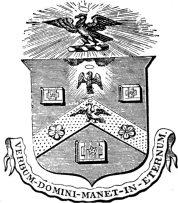Stationers Company
 |
|
| Location | Stationers' Hall, London |
|---|---|
| Date of formation | 1403 |
| Company association | Printing and publishing |
| Order of precedence | 47th |
| Master of company | Nick Steidl |
| Motto | Verbum Domini Manet In Aeternum |
| Website | stationers |
The Worshipful Company of Stationers and Newspaper Makers (until 1937 the Worshipful Company of Stationers), usually known as the Stationers' Company, is one of the Livery Companies of the City of London. The Stationers' Company was formed in 1403; it received a Royal Charter in 1557. It held a monopoly over the publishing industry and was officially responsible for setting and enforcing regulations until the enactment of the Statute of Anne in 1710. Once the Company received its Charter, “the Company’s role was to regulate and discipline the industry, define proper conduct and maintain its own corporate privileges.”
Its members (Master, Wardens, Assistants, Liverymen, Freemen and Apprentices) are mostly involved with the modern visual and graphic communications industries which have evolved from the company's original trades. These include printing, papermaking, packaging, office products, engineering, advertising, design, photography, film and video production, publishing of books, newspapers and periodicals and digital media. The Company's principal purpose nowadays is to provide an independent forum where its members can advance the interests (strategic, educational, training and charitable) of the industries associated with the Company.
In 1403, the Corporation of London approved the formation of a Guild of Stationers. At this time, stationers were either text writers, lymners (illuminators), bookbinders or booksellers who worked at a fixed location (stationarius) beside the walls of St Paul's Cathedral. Booksellers sold manuscript books, or copies thereof produced by their respective firms for retail; they also sold writing materials. Illuminators illustrated and decorated manuscripts.
Printing gradually displaced manuscript production so that, by the time the Guild received a Royal Charter of Incorporation on 4 May 1557, it had in effect become a Printers' Guild. In 1559, it became the 47th in City Livery Company precedence. At the time, it was based at Peter's College, which it bought from St Paul's Cathedral. During the Tudor and Stuart periods, the Stationers were legally empowered to seize "offending books" that violated the standards of content set down by the Church and State; its officers could bring "offenders" before ecclesiastical authorities, usually the Bishop of London or the Archbishop of Canterbury depending on the severity of the transgression. Thus the Stationers played an important role in the culture of England as it evolved through the intensely turbulent decades of the Protestant Reformation and toward the English Civil War.
...
Wikipedia
